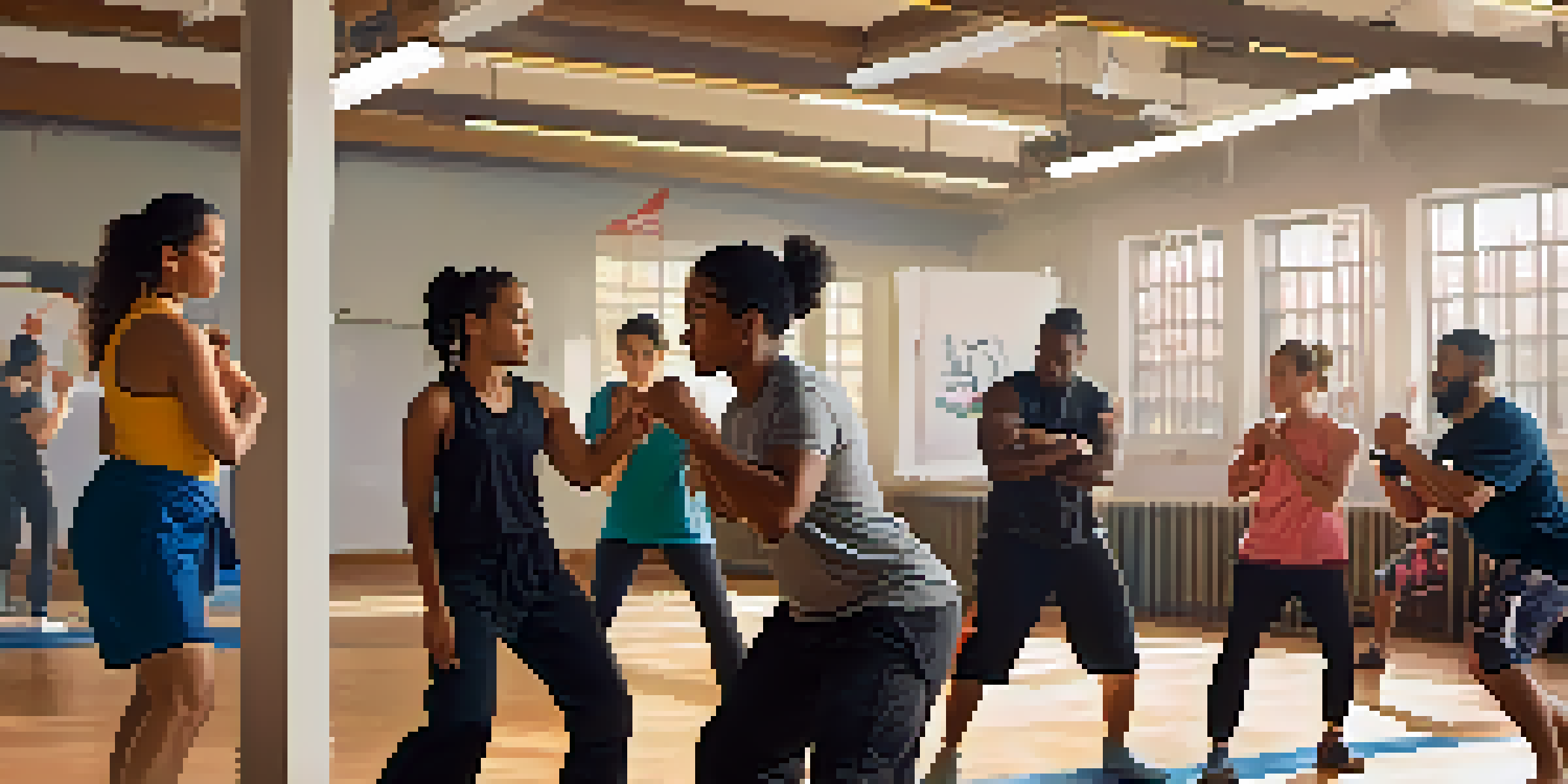Self Defense Awareness for Students in Urban Environments

Understanding the Importance of Self Defense for Students
In today’s urban landscape, students may find themselves in unfamiliar or potentially risky situations. Understanding self-defense is not just about physical skills; it’s about awareness and prevention. By being proactive, students can navigate their environments more safely and confidently.
The best defense is a good offense.
Self-defense awareness equips students with the knowledge to recognize potential threats before they escalate. This means being alert to your surroundings, trusting your instincts, and knowing when to seek help. It’s about cultivating a mindset that prioritizes safety in everyday life, especially in bustling city settings.
Moreover, knowing how to defend oneself boosts confidence and reduces anxiety. When students feel secure in their ability to handle unforeseen circumstances, they can focus on their studies and social experiences without unnecessary worry. Ultimately, self-defense goes hand in hand with personal empowerment.
Recognizing Potential Threats in Urban Environments
Urban environments, while vibrant, can also present unique challenges. Students should be trained to identify potential threats, such as aggressive individuals or unsafe areas. Awareness is key; if something feels off, it probably is, and students should act accordingly.

For instance, if a student notices someone following them or loitering suspiciously, it’s essential to remain calm and assess the situation. Looking for safe spaces, like shops or well-lit areas, can be a practical strategy. Remember, it’s better to be cautious than to ignore warning signs.
Self-Defense Builds Awareness
Understanding self-defense enhances students' ability to recognize and respond to potential threats in their environment.
Additionally, understanding common scams and tactics used by predators can further enhance awareness. Educating oneself about these tactics—like distraction techniques—empowers students to think critically and respond appropriately to unexpected situations.
Effective Communication and Conflict Resolution Skills
One of the most powerful tools in self-defense is communication. Learning how to assertively express discomfort or set boundaries can often diffuse a potentially dangerous situation. Verbal self-defense is about using words effectively to establish control and deter unwanted attention.
Awareness is the greatest agent for change.
In addition to assertiveness, students should practice conflict resolution skills. Engaging in open dialogue and seeking peaceful solutions can prevent altercations from escalating. For example, if a disagreement arises, calmly discussing the issue may lead to a resolution without resorting to physical confrontation.
Moreover, honing these skills can create a more positive social environment. When students feel comfortable communicating their needs and conflicts, it fosters mutual respect and understanding, reducing the likelihood of violent encounters.
Basic Physical Self Defense Techniques for Everyone
While awareness and communication are crucial, knowing a few basic self-defense techniques can be invaluable. Students don’t need to be martial arts experts; simple moves can make a significant difference. Techniques like the palm strike or knee strike can help create space to escape from a threat.
It’s beneficial to practice these techniques in a safe setting, perhaps through a self-defense class or workshop. Engaging with a certified instructor can provide students with the right skills and confidence to defend themselves if necessary. Plus, it’s a great way to meet new people and build community.
Communication Diffuses Conflict
Effective communication and conflict resolution skills can prevent dangerous situations from escalating.
Remember, the goal of self-defense isn’t to engage in a fight but to protect oneself and escape to safety. With practice, students can feel empowered, knowing they have the tools to handle uncomfortable situations.
Utilizing Technology for Personal Safety
In our tech-savvy world, students can leverage technology to enhance their safety. Apps that share location with trusted contacts or alert authorities in emergencies can provide an added layer of security. Familiarizing oneself with these tools can make a significant difference in critical moments.
For example, personal safety apps often feature options to send emergency texts or share live location data. Some even include a panic button that contacts local authorities immediately. By integrating these technologies into their daily routines, students can feel more secure while navigating urban spaces.
However, it’s essential to remember that technology should complement, not replace, personal awareness. Students should still prioritize being alert and aware of their surroundings, using technology as an additional tool in their safety toolkit.
Building a Support Network Among Peers
Creating a strong support network among peers can enhance safety in urban environments. Students should encourage each other to look out for one another, whether walking to class or attending social events. A buddy system can be an effective way to ensure everyone gets home safely, especially at night.
In addition to physical companionship, students can also share resources and safety tips, fostering a community of awareness. Regular discussions about safety concerns and experiences can empower everyone to take proactive steps. Building this culture of support can make urban living feel less daunting.
Support Networks Enhance Safety
Creating a strong support network among peers fosters a sense of security and encourages proactive safety measures.
Moreover, having a reliable support network provides emotional reassurance. Knowing that friends are looking out for one another fosters a sense of belonging and security, making the urban student experience more enjoyable.
Empowering Students Through Self Defense Education
Educational institutions play a crucial role in promoting self-defense awareness among students. By offering workshops, classes, or seminars, schools can equip students with the necessary tools to protect themselves. Self-defense education should be seen as an essential part of student life.
Moreover, integrating self-defense topics into orientation programs can help new students feel more secure in their new environment. This proactive approach not only teaches valuable skills but also creates a culture of safety and awareness within the campus community.

Ultimately, empowering students through education can reduce fear and anxiety, allowing them to focus on their academic and personal growth. When students feel prepared and knowledgeable, they can fully embrace their urban experiences without fear.